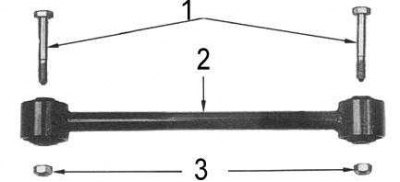Note. The following procedures require a press, suitable mandrels and pipes.
Removing
Upper torque arm
1. Jack up the rear of the vehicle on the appropriate side and place it on jack stands placed under the chassis frame and rear axle assembly.
2. If necessary, remove the corresponding rear wheel.
3. Give a nut of a bolt of fastening of a jet bar to an arm of the bridge. Be careful not to damage the brake lines.
4. Give a nut of a bolt of fastening of a jet bar to an arm of a frame of the chassis.
5. Remove the bolts by knocking them out with a brass drift (support the bar while driving out the bolts). Longitudinal reaction rod rear suspension with fasteners shown in the accompanying illustration.

1 - bolts; 2 - longitudinal reactive rod; 3 - nuts
6. Remove the torque arm from the vehicle.
7. Inspect the torque rod for cracks and signs of deformation and replace if necessary.
8. Check the condition of the bushings in the torque arm. Replace defective bushings:
- Support the rod under the sleeve to be replaced with a piece of pipe of suitable diameter (the sleeve must pass freely through the pipe).
- Using a tool whose mandrel will rest against the outer steel tube of the bushing, press the bushing out of the rod.
- Moisten the outer surface of the new bushing with soapy water and begin to gradually push the bushing into place with a piece of pipe that will rest against the outer steel tube of the bushing.
- Make sure the bushing is square and centered.
Lower longitudinal torque rod
1. Jack up the rear of the vehicle on the appropriate side and place it on jack stands placed under the chassis frame and rear axle assembly.
2. Remove the appropriate rear wheel.
3. Give a nut of a bolt of fastening of a jet bar to an arm of the bridge.
4. Give a nut of a bolt of fastening of a jet bar to an arm of a frame of the chassis.
5. Remove the bolts by knocking them out with a brass drift (support the bar while driving out the bolts).
6. Remove the torque rod from the car, remembering its installation position - the ends of the rod are slightly offset.
7. Inspect the torque rod for cracks and signs of deformation and replace if necessary.
8. Check the condition of the bushings in the torque arm. Replace defective bushings:
- Support the rod under the sleeve to be replaced with a piece of pipe of suitable diameter (the sleeve must pass freely through the pipe).
- Using a tool whose mandrel will rest against the outer steel tube of the bushing, press the bushing out of the rod.
- Moisten the outer surface of the new bushing with soapy water and begin to gradually push the bushing into its seat using a piece of pipe that will rest against the outer steel tube of the bushing.
- Make sure the bushing is square and centered.
Installation
Installation is in the reverse order.
1. If bushings have been replaced, carefully check the condition of the rod axle bolts. Replace worn components.
2. Install the torque rod on the car, install the fasteners (nuts, washers and rubber bushings), but do not completely tighten it at this stage. Lower the car to the ground.
3. Rock the car several times to shrink the suspension components, then tighten the nut securing the rod to the chassis frame with a force of 147÷177 Nm.
4. Tighten the nuts securing the rods to the bridge with a force of 98÷137 Nm.